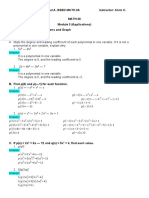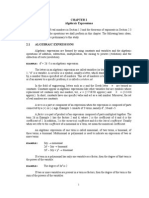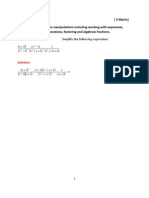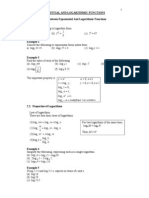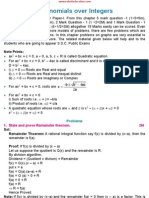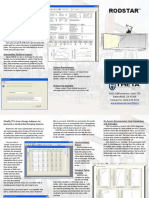Section 6 - Algebra 1
Section 6 - Algebra 1
Uploaded by
Celle RichCopyright:
Available Formats
Section 6 - Algebra 1
Section 6 - Algebra 1
Uploaded by
Celle RichOriginal Description:
Copyright
Available Formats
Share this document
Did you find this document useful?
Is this content inappropriate?
Copyright:
Available Formats
Section 6 - Algebra 1
Section 6 - Algebra 1
Uploaded by
Celle RichCopyright:
Available Formats
1
ALGEBRA 1
Algebraic Expressions
A coefficient is the number in front of a letter in an
algebraic term, e.g. in the algebraic term 4a, 4 is the
coefficient of a.
All algebraic terms have two or more factors
Example
The factors of 5a are 1, 5, a and 5a.
The degree of a polynomial is the highest power that
the variable is raised in the algebraic expression
Example
The degree of the polynomial
x3
+4
x2
+ x + 1 is 3.
In the case of a multivariable polynomial, the degree is
found by adding the highest index of each variable
Example
The degree of the polynomial 5
x y
+ 4x
+ y is 5.
Binary Operations
A binary operation refers to a clearly defined
computational process that can be carried out on two
elements at a time
Example
a * b = 2a b
In the operation a * b = 2a b , * is the symbol of the
operation and b is the term that comes after the symbol of
the operation.
Then 2a b means 2 * a b.
Application of the rule that governs a binary operation.
Commutative and Associative properties of binary
operation
Laws of Indices
Multiplication
When multiplying powers of the same quantity together
add the indices.
x6
x7
x 6+7
x 13
Division
When dividing powers of the same quantity subtract the
index of the denominator (bottom part) from the index of
the numerator (top part)
a)
x5
x2
b)
a xa xa
5
7
a xa
=
4
52
3+ 4+8
a
5+7
a
a15
12
a
=
c)
3 y2 x 2 y5 x 5 y 4
6 y3 x 4 y4
a1512
30 y 2 +5+4
24 y 3+ 4
a3
30 y 11
24 y 7
5 y 117
4
5 y4
4
Powers
When raising the power of a quantity to a power multiply
the indices together.
3
1)
(3 x)
2)
a b c
2 x2
3 m3
2
5n
3)(
31 x 3
3 x2
x 1 x3
x
c
4 x2
3 2 m3 x 2
2 2 x2
5 n
33
a b c
9 m6
4
25 n
x3
= 27
x3
Negative Indices
A negative index indicates the reciprocal of the quantity.
a)
b)
5 x3
c)
2 3
a b c
1
a
5
x3
a2
b2 c3
Fractional Indices
The numerator of a fractional index indicates the power to
which the quantity must be raised; the denominator
indicates the root which is to be taken.
2
= x
1)
x3
2)
ab 4
3)
a2
4 3
=ax x
(Note that for square roots the number indicating the root
is usually omitted.)
64 a6 = (
1
6 2
=(
64 a
8
2x
1
2
6x
1
2
8 a
1
2
8 a3
Zero Index
Any quantity raised to the power of zero is equal to 1.
0
1) a = 1
x
2)( y = 1
0
Example 1
1 4
1)(
2)
42
1
14
1
34
1
4
3
=(
=
= 2 = 32
22 2
1
1
4
3
34
4
1
= 81
2 5
x
2
21
2
3) 9 x = (
32 x 2 2
=
31 x 1
2 1
x
2
31
2 1
x
2
x1
= 3x
Example 2
If
3 p+ 4
9 p2
p+ 4
p+ 4
=(
p+ 4
find the value of p.
p2
p2
2 p4
Since (p + 4) and (2p - 4) are both powers of 3, they must
be equal.
p + 4 = 2p - 4
p + 4 + 4 = 2p
4 + 4 = 2p - p
p=8
Exercise
Simplify the following:
1)
35 x 32 x 37
2)
b2 x b 4 x b5 x b 8
3)
57
52
4)
23 x 2 4 x 27
22 x 25
5)(
72 3
6)(
y
3 x2 4
7)
8)(
b c
2
5
a
5 a3
2b 2
9)Find the values of:
101
and
34
10)Find the values of:
1
3
and
2
11)Express as powers of 3:
13)Find the values of:
14)Find the values of: (
15)Find the values of
m
16)If
17)If
2x +1
18)If
52 x+ 3
1 0
p
q
27
81
, x , x
3 x
12)Express as powers of x :
32 5
32
1
5
25 2
13
125
, (1,000,000
when p=
27 3
64
2
3
and q=
= 9, find m.
=
=
4x
find x.
125x +5
, find x.
19)Find the values of p for which
20)Find the values of x if
Removal of Brackets
( 22 x )
32 p1
( 4 x+1 )
= 243
= 64
32
Distribution of multiplication over addition and
subtraction when brackets are removed in an algebraic
expression
Example
a(x + y) = ax + ay
a(x y) = ax ay
Each term inside the brackets must be multiplied by the
term immediately outside the brackets.
The term outside the brackets is called the
multiplier.
In the case where the multiplier is negative,
Example
-a(x + y) = -ax - ay
-a(x y) = ax + ay
The signs in the brackets are changed when the brackets
are removed.
10
Exercises
Remove the brackets from each of the following
expressions simplifying your answers where appropriate.
1)8(3 + 2y)
2) 7(x + y)
3) 7(x + y)
4) (3 + 2x)
5) (3 2x)
6) (3 2x)
7) x(x + 1)
8)15(x + y)
9)15(xy)
10)
11(m + 3n).
Expanding Algebraic Expressions
Multiplication of a binomial by a binomial
11
Example
(x + 2)(x + 3) = x(x + 3) + 2(x + 3)
Each term of the first bracket serves as a multiplier for the
terms in the second bracket.
By the distributive law the product is:
x2
+ 3x + 2x + 6 =
x2
+ 5x + 6
Expand each of the following
a) (x + 2)(x + 3)
b) (a + b)(c + 3)
c) (y 3)(y + 2)
d) (2x + 1)(3x 2)
e) (3x 1)(3x + 1)
12
f) (5x 1)(x 5)
g) (2p + 3q)(5p 2q)
h) (x + 2)(2
x2
x 1)
i) (4p + 3)(2p q 5)
j) (2z + 3)(2z + 3)
k) (
l) (3
x2
x2
2x + 1)(
x2
+ 4x + 3)
2x + 1)(
x2
4x 5)
Simplifying Algebraic Fractions
Algebraic fraction
13
Example
x
3
5x
6
In addition and subtraction of algebraic fractions, the
LCM of the denominators is first obtained
Example
x
3
5x
6
7x
6
x +5 x
6
Exercise
1)
x
3
2)
2a
3
a
5
3)
4
5a
1
2a
4)
2
n
3
2n
x
4
14
5)
3 x+ y
10
x3 y
15
6)
a5 b
5
2 a+ b
2
7)
3 (2 x + 4)
5
8)
2
x +1
3
x1
9)
4
2 a1
2(3 x2)
3
1
a2
10)
6
n3
11)
3
x2
12)
3
x
5
n+2
2
2x
4
x
Factors and multiples of algebraic terms
15
In the problem 3 x 4 = 12, 3 and 4 are factors and 12 is
the product.
Factoring is like taking a number apart. It means to
express a number as the product of its factors.
Factors are either composite numbers or prime
numbers (except that 0 and 1 are neither prime nor
composite).
The number 12 is a multiple of 3, because it can be
divided evenly by 3.
Example
3 x 4 = 12
3 and 4 are both factors of 12
12 is a multiple of both 3 and 4
Factors and multiples of algebraic terms.
You might also like
- The Product Book 2nd EditionDocument304 pagesThe Product Book 2nd EditionAndrew Richard Thompson100% (18)
- Math Study Guide Notes For Final Exam MCR3U Grade 11 FunctionsDocument31 pagesMath Study Guide Notes For Final Exam MCR3U Grade 11 FunctionsSujith NimalarajNo ratings yet
- Index and LogDocument15 pagesIndex and LogSuresh Rao AppannahNo ratings yet
- Gen. Math Summary of Topics2Document7 pagesGen. Math Summary of Topics2Rann M100% (1)
- Precal m2Document9 pagesPrecal m2RechelleNo ratings yet
- Active Mathematics PDFDocument22 pagesActive Mathematics PDFgoingforward77No ratings yet
- Algebraic ExpressionsDocument32 pagesAlgebraic ExpressionsGelvie LagosNo ratings yet
- Math Methods CAS Unit 3&4 - Ch4Document43 pagesMath Methods CAS Unit 3&4 - Ch4Anonymous na314kKjOANo ratings yet
- Chapter 2Document14 pagesChapter 2jayar0824No ratings yet
- Mathematical Methods For Business, Economics & FinanceDocument67 pagesMathematical Methods For Business, Economics & FinanceHareen JuniorNo ratings yet
- Topic 1 POLYNOMIALSDocument69 pagesTopic 1 POLYNOMIALSNorlianah Mohd ShahNo ratings yet
- Further Mathematics NoteDocument24 pagesFurther Mathematics NoteAdeolaNo ratings yet
- Module1.1 PolynomialsDocument34 pagesModule1.1 PolynomialsBrent Reyes PalayonNo ratings yet
- Week 1 - PPT 1 - AMG 211 (Basic Algebraic Operations To Equations and Inequalities)Document36 pagesWeek 1 - PPT 1 - AMG 211 (Basic Algebraic Operations To Equations and Inequalities)not funny didn't laugh100% (1)
- JS 2 Maths Lesson NoteDocument22 pagesJS 2 Maths Lesson NotemerisonconceptNo ratings yet
- Schaum's Outline College AlgebraDocument11 pagesSchaum's Outline College AlgebraJacob Alday Santos67% (6)
- Group 01: Noorfadzlina Binti Hassan Zul Izwan Bin Radzak Gunalan A/L SanasieDocument37 pagesGroup 01: Noorfadzlina Binti Hassan Zul Izwan Bin Radzak Gunalan A/L SanasieAswaja313No ratings yet
- MATH26 M4 Applications Manguilimotan BSEDMath3ADocument11 pagesMATH26 M4 Applications Manguilimotan BSEDMath3ARetchel ManguilimotanNo ratings yet
- Quadratics CH 4Document48 pagesQuadratics CH 4yddapNo ratings yet
- Balik Aral (Algebra)Document17 pagesBalik Aral (Algebra)Mj DimapilisNo ratings yet
- CHAP2Document11 pagesCHAP2Remington SalayaNo ratings yet
- Group 1: Noorfadzlina Binti Hassan (Ta18003) Zul Izwan Bin Radzak (Ta18017) Gunalan A/L Sanasie (Ta18011)Document42 pagesGroup 1: Noorfadzlina Binti Hassan (Ta18003) Zul Izwan Bin Radzak (Ta18017) Gunalan A/L Sanasie (Ta18011)Aswaja313No ratings yet
- CH 4Document55 pagesCH 4Lawrence Dumalag100% (1)
- Chap 02.3 Partial Fraction2011Document5 pagesChap 02.3 Partial Fraction2011KHKwongNo ratings yet
- Chapter 3Document21 pagesChapter 3wagapak111No ratings yet
- Different Strategies in Factoring PolynomialsDocument4 pagesDifferent Strategies in Factoring PolynomialsGlaiza QuingNo ratings yet
- Integer Exponents: A A A A ADocument5 pagesInteger Exponents: A A A A Achloe NavarroNo ratings yet
- Kirill's Training ListDocument7 pagesKirill's Training ListOIDBoYNo ratings yet
- The Binomial TheoremDocument9 pagesThe Binomial Theoremray469859No ratings yet
- Unit 7 Test Review Fall 2021Document2 pagesUnit 7 Test Review Fall 2021BobNo ratings yet
- Chapter 8.1 - Common Monomial FactorsDocument7 pagesChapter 8.1 - Common Monomial FactorsJoy Masipag-SeminianoNo ratings yet
- Solution:: Simplify The Following ExpressionDocument9 pagesSolution:: Simplify The Following ExpressionOsama HassanNo ratings yet
- Chapter 2 Quadratic Expressions and EquationsDocument91 pagesChapter 2 Quadratic Expressions and Equationsjuriah binti ibrahimNo ratings yet
- C1C2 Revision NotesDocument12 pagesC1C2 Revision NotesWillMeadNo ratings yet
- Polynomials: Nur Liyana BT Za'Im Siti Izzati Dyanah BT Zainal Wan Izzah KamilahDocument39 pagesPolynomials: Nur Liyana BT Za'Im Siti Izzati Dyanah BT Zainal Wan Izzah KamilahLiyana Za'imNo ratings yet
- PolynomialsDocument17 pagesPolynomialschand7790100% (3)
- 3, Factors and PolynomialsDocument11 pages3, Factors and Polynomialstahsinhaideresha81No ratings yet
- Algebraic FractionDocument6 pagesAlgebraic FractionJRMSU-TC Ginn Lloyd GamilNo ratings yet
- Add MathsDocument40 pagesAdd MathsJoseph TingNo ratings yet
- When You Multiply by A Negative Number The Inequality Sign Changes DirectionDocument16 pagesWhen You Multiply by A Negative Number The Inequality Sign Changes Directionaly jacksonNo ratings yet
- Integral PowerpointDocument16 pagesIntegral PowerpointJan Albert Alavaren100% (1)
- ALGEBRADocument19 pagesALGEBRAsantoserzeljohnNo ratings yet
- Class 9 Maths Ws 06 PDFDocument9 pagesClass 9 Maths Ws 06 PDFPoorv KantNo ratings yet
- Chapter 3 (Techniques of Integration)Document8 pagesChapter 3 (Techniques of Integration)S M AkashNo ratings yet
- 1 2 1 1 2 PDFDocument17 pages1 2 1 1 2 PDFFredrick RodriguesNo ratings yet
- 2012 Differentiation Barely PassedDocument10 pages2012 Differentiation Barely PassedcsanjeevanNo ratings yet
- Reviewer in Mathematics 1st QuarterDocument6 pagesReviewer in Mathematics 1st QuarterIrish AtienzaNo ratings yet
- 004-Sets Operation On PolynomialsDocument43 pages004-Sets Operation On Polynomialscherry agaNo ratings yet
- 2003 Test BDocument10 pages2003 Test BDerny FleurimaNo ratings yet
- Reviewer in MATH 7 3 Periodical Test Content UpdateDocument4 pagesReviewer in MATH 7 3 Periodical Test Content UpdateGayzelNo ratings yet
- Topic 2 - Logarithmic and ExponentialDocument8 pagesTopic 2 - Logarithmic and Exponentialapi-258876060% (1)
- Polynomials Over Integers: Note PrintsDocument14 pagesPolynomials Over Integers: Note PrintsKomanduri Murali SrinivasNo ratings yet
- Math Handout Level 3Document46 pagesMath Handout Level 3BayanNo ratings yet
- Algebraic Expressions ExerciseDocument18 pagesAlgebraic Expressions ExerciseLi Ann ChungNo ratings yet
- Factoring and Algebra - A Selection of Classic Mathematical Articles Containing Examples and Exercises on the Subject of Algebra (Mathematics Series)From EverandFactoring and Algebra - A Selection of Classic Mathematical Articles Containing Examples and Exercises on the Subject of Algebra (Mathematics Series)No ratings yet
- Analytic Geometry: Graphic Solutions Using Matlab LanguageFrom EverandAnalytic Geometry: Graphic Solutions Using Matlab LanguageNo ratings yet
- Animals From A - ZDocument4 pagesAnimals From A - ZCelle RichNo ratings yet
- Answer To QuestionDocument1 pageAnswer To QuestionCelle RichNo ratings yet
- Places From Which Early Families in Guyana CameDocument4 pagesPlaces From Which Early Families in Guyana CameCelle RichNo ratings yet
- Answer To Question TrigDocument3 pagesAnswer To Question TrigCelle RichNo ratings yet
- Sets - Grade 9Document4 pagesSets - Grade 9Celle RichNo ratings yet
- Subject and Verb AgreementDocument19 pagesSubject and Verb AgreementCelle RichNo ratings yet
- Section 7 - Number Theory 2Document5 pagesSection 7 - Number Theory 2Celle RichNo ratings yet
- Section 5 - Ratio and ProportionDocument11 pagesSection 5 - Ratio and ProportionCelle RichNo ratings yet
- Photosynthesis TestDocument2 pagesPhotosynthesis TestCelle RichNo ratings yet
- Social Studies Grade 3Document11 pagesSocial Studies Grade 3Celle RichNo ratings yet
- Section 4 - MeasurementDocument3 pagesSection 4 - MeasurementCelle RichNo ratings yet
- Section 3 - ComputationDocument7 pagesSection 3 - ComputationCelle RichNo ratings yet
- How The Africans Came To GuyanaDocument2 pagesHow The Africans Came To GuyanaCelle RichNo ratings yet
- Quotation Marks: ExampleDocument3 pagesQuotation Marks: ExampleCelle RichNo ratings yet
- Section 1 - SetsDocument15 pagesSection 1 - SetsCelle RichNo ratings yet
- Amerindians CraftDocument1 pageAmerindians CraftCelle RichNo ratings yet
- Amerindians in Guyana FoodDocument1 pageAmerindians in Guyana FoodCelle RichNo ratings yet
- A Guinea PigDocument1 pageA Guinea PigCelle RichNo ratings yet
- I Opened A Book by Julia DonaldsonDocument1 pageI Opened A Book by Julia DonaldsonCelle RichNo ratings yet
- A Baby SermonDocument1 pageA Baby SermonCelle RichNo ratings yet
- Turban Chapter 13Document13 pagesTurban Chapter 13Pingkan Mayosi F.No ratings yet
- BPO BenchmarkDocument2 pagesBPO BenchmarkShaun DunphyNo ratings yet
- Informatica TeradataDocument21 pagesInformatica TeradataSanthuMithinti100% (1)
- Introduction To Hacking Postgresql: With Lots of Code Review!Document84 pagesIntroduction To Hacking Postgresql: With Lots of Code Review!Med BahbaNo ratings yet
- Lecture 4 Slides DFT Sampling TheoremDocument32 pagesLecture 4 Slides DFT Sampling TheoremhaldoisNo ratings yet
- Course Profile - CSE 122Document4 pagesCourse Profile - CSE 122Md. Ramjan Ali 211021003No ratings yet
- CSE 3yr Syllabus 240920Document40 pagesCSE 3yr Syllabus 240920RekhasreeGoneNo ratings yet
- Building An IoT Botnet - BSides Manchester 2016 - MDSec - Usando HIKVISION DVRs BusyboxDocument17 pagesBuilding An IoT Botnet - BSides Manchester 2016 - MDSec - Usando HIKVISION DVRs BusyboxHugo MüllerNo ratings yet
- Sap PP Master DataDocument1 pageSap PP Master DatadkpdharmNo ratings yet
- Au NPIV PDFDocument20 pagesAu NPIV PDFvkky2k8120No ratings yet
- 17.5 Automated Allocation of Mesh PointsDocument2 pages17.5 Automated Allocation of Mesh PointsVinay GuptaNo ratings yet
- Change Management PlanDocument7 pagesChange Management PlanAsruni Artamevia Julianti AskarNo ratings yet
- Relational Algebra: Operators Expression TreesDocument28 pagesRelational Algebra: Operators Expression TreesYatin NimeshNo ratings yet
- Tugas 1 SMBDDocument6 pagesTugas 1 SMBDMochammad Adji FirmansyahNo ratings yet
- Final Model 2 With Random Effects: The Mixed ProcedureDocument3 pagesFinal Model 2 With Random Effects: The Mixed ProcedureCamille Anne CelizNo ratings yet
- Pulse and Digital Circuits: What Is A Counter?Document7 pagesPulse and Digital Circuits: What Is A Counter?Gaurang VishnoiNo ratings yet
- Rodstar BrochureDocument2 pagesRodstar BrochurePierina Jaimes PirelaNo ratings yet
- NCE V100R018C10 Communication Port Matrix 01-CDocument346 pagesNCE V100R018C10 Communication Port Matrix 01-CyugNo ratings yet
- Osa 5410 SeriesDocument6 pagesOsa 5410 SeriesvinothsanNo ratings yet
- Recursive Backtracking For Solving 99 Sudoku PuzzlDocument4 pagesRecursive Backtracking For Solving 99 Sudoku PuzzlRitesh sharmaNo ratings yet
- Data Science - TrelloDocument10 pagesData Science - TrellokhanmdNo ratings yet
- Week 11 Tutorial Identify and Correct Misplaced and Dangling ModifiersDocument1 pageWeek 11 Tutorial Identify and Correct Misplaced and Dangling Modifiers03152788No ratings yet
- Copystar CS2020 SpecsDocument1 pageCopystar CS2020 SpecsLaser-Way Office-MachinesNo ratings yet
- Lecture 3Document7 pagesLecture 3xssdNo ratings yet
- SALT ProPresenter Keyboard Shortcuts MacDocument1 pageSALT ProPresenter Keyboard Shortcuts MacJosé SolórzanoNo ratings yet
- Stratix 2000 SwitchesDocument2 pagesStratix 2000 SwitchesMarisurNo ratings yet
- Real-Time Translator From OpenGL To OpenGL ES ForDocument4 pagesReal-Time Translator From OpenGL To OpenGL ES ForElmerNo ratings yet
- Swap Magic Code R ManualDocument3 pagesSwap Magic Code R ManualkorrakorraNo ratings yet
- Differential Drive RobotDocument18 pagesDifferential Drive RobotJunaid IftikharNo ratings yet


















